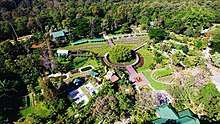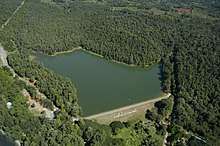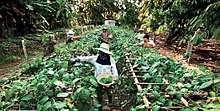Huai Hong Khrai Royal Development Study Centre
Huai Hong Khrai Royal Development Study Centre (Thai: ศูนย์ศึกษาการพัฒนาห้วยฮ่องไคร้อันเนื่องมาจากพระราชดำริ) is an institution in Chiang Mai, Thailand.
History



Thailand's Northern Region has abundant forests and natural resources such as minerals, wildlife, wild plants and various forest products. The region is recognized to be the area of great value and significance both in the ecological and economic aspects.
However, a large number of the forest areas had been destroyed due to the deterioration of the forests, the expansion of land for agricultural activities, and the occurrence of forest fires. Particularly, there were several problems in the area of Khun Mae Kuang National Forest Reserve where the Huai Hong Khrai Royal Development Study Centre is presently located. Forests were deteriorated, ineffective in retaining water and with only 35 plant species found. The watersheds contained a little natural water. The area was arid and lack of humidity, inducing the occurrence of forest fires every year. The soil was acidic, inappropriate for agricultural activities.
Recognizing the impacts resulting from the loss of forests upon the watershed areas, His Majesty King Bhumibol Adulyadej paid a keen attention to develop and conserve the forests. His Majesty, therefore, initiated the establishment of the Huai Hong Khrai Royal Development Study Centre on 11 December 1982. The centre covers an area of about 1,360 hectares in the Huai Hong Khrai Basin, which is part of Khun Mae Kuang National Forest Reserve and situated in Doi Saket District of Chiang Mai Province. Currently, its services have been extended to 18 surrounding villages. The centre's activities involved the works of 17 government agencies and the representative of the Royal Irrigation Department which oversees the centre's main activities and acts as director of the centre.
Objectives
The establishment of Huai Hong Khrai Royal Development Study Centre aims at solving problems for people in the remote areas so that they can have a better quality of life and be free from hardship. The objectives and guidelines of the Centre include the followings
- To conduct study, research and experiments in search of guidelines and development methods suitable for different conditions of the areas in Northern region
- To provide technical knowledge with practical theories which will enhance people's capacity to carry out the development work and create the maximum benefits
- To function as a one stop service that gathers results of study, experiments and demonstrations which have proven successful, be it from the fields of agriculture, water resources, livestock, fishery and social development, presented in a form of a "living natural museum"
- To serve as a place for the exchange of experiences and open communication among academics, development workers and the people
- To coordinate with various stakeholders on project planning and management in order to render optimum benefits
Activities
Major project activities initiated to date by the Huai Hong Khrai Royal Development Study Centre can be listed as follows:
1. Development of Water Sources
- Managing water sources, both natural and man-made, and both above and under the ground
- Planning and developing the water delivery system and the distribution of water supply
- Building the fish-bone system irrigation canals to disperse water to increase moisture in the soil
which will also be useful for reforestation and the connecting of basins. This thus helps increase the quantity of water in the areas affected by water shortage while helping to release the excess water in the areas with too much water.
- Building and improving check dams to ensure efficient use
2. Development of Soil
- Implementing the integrated management of soil and plants for sustainable agriculture
- Growing organic vegetables
- Growing various crops in eroded soil
- Applying biological products with fruit crops
- Studying land use systems in the slope areas and their impact on the ecology of the area at the Huai Hong Khrai basin
- Studying the impact of the use of moisture systems in the forest areas which includes the demonstration of the use of water flow from the mountains
- Adopting natural methods such as compost and liquid bio-fertilizer coupled with soil nourishment crops
- Propagating vetiver grass for distribution among the farmers and collecting various vetiver ecotypes
- Planting vetiver grass for soil and water conservation by different methods e.g. along the contour lines, across the gullies, in orchards to maintain soil moisture etc.
3. Development of Forestry
- Developing four systems of forest which are the natural system, the check dam system, the irrigation system and the check dam system together with the construction of reservoirs. Check dams are constructed to retard the water flow, collect water to preserve the humidity in the area and trap soil sediments, leading to the existence of wet fire breaks. Besides, the control and prevention of forest fires is undertaken through various public relations media such as mobile public relations units, billboards, exhibitions, training of communities and youth, and setting up of fire volunteers.
- Planting three types of forest trees which are cut for fruits, fire wood and timber for reforestation in irrigated areas, reforestation in valley areas with check dams to help maintain the moisture and reforestation in rain-fed areas. The principle for planting the various types of trees is to plant the trees from the top of the mountain using trees which have seeds to allow the natural dispersion of seeds from the top of the mountain to the low ground. This method will create thick and dense forests.
- Preserving and propagating wildlife species such as barking deer, mouse deer, monkey, gibbon, peacock and various kinds of birds; studying the breeding of wildlife; studying the behaviours of wildlife in their natural habitats; and studying the increase of wildlife population
- Promoting people participation and consciousness for forest and wildlife conservation so that people can live sustainably with the forest
4. Development of Crop Cultivation
- Planting rice
 Chiang Da Herb, HHK
Chiang Da Herb, HHK - Planting field crops e.g. sugar cane, para rubber, paper mulberry
- Growing fruit crops e.g. mango, longan, lychee
- Experimenting on organic crops e.g. rice, sticky rice, longan
- Growing and collecting herbal plants and aromatic plants
- Growing and collecting native vegetables and Arabica coffee
- Producing nontoxic vegetables
- Promoting mushroom culture and the use of mango branches for herbal mushroom culture
- Breeding earth worm for compost making and agricultural uses
- Experimenting the use of physic nuts and propagating them for further distribution to communities
5. Development of Intensive Farming
- Demonstrating the different systems of intensive farming such as agro-industry type horticulture and horticulture integrated with livestock farming
- Collecting various kinds of plants such as native vegetables, herbal plants, aromatic plants as well as fruit crops and ornamental plants
- Improving varieties of plants with potentials for usages such as hemp
- Collecting plant genetics such as wild mushroom, wild plants that have potentials for industrial use, wild orchids and local ecotypes of vetiver grass. The work also combines the planting of perennial trees for food, firewood and income with that of annual plants for food, medicine and income.
- Promoting multi-cropping with emphasis on studying the species of plants which the farmers are already familiar with
6. Development of Animal Husbandry
- Demonstrating the raising and breeding of cattle, milch cow, poultry, pigs and milch goats
- Growing different varieties of animal fodder such as Guinea grass, Ruzi grass and Mulato grass to find the suitable ones for feeding the animals
7. Development of Fishery

- Demonstrating the appropriate methods for aquaculture
- Promoting fish raising in round cement ponds installed with the flowing water system, fish raising in the floating baskets and fish raising in the watercourses where there is natural water flow
- Breeding fresh water animals for releasing in reservoirs, ponds and natural water sources in the villages as well as for distributing among farmers, schools and agencies
- Providing fish breeds and food tablets to schools in the surrounding villages together with promoting the raising of fresh water fish such as catfish, Nile Telapia
- Encouraging the farmers to form groups and receive training on the management of fishery
8. Development of Frog Farming

- Researching on frog farming development integrating with natural conservation
- Dissemination of technical know-hows and samples of frog farming to farmers
- Studying and researching on amphibian biodiversity for sustainable conservation of environment
9. Development of Community
- Promoting the creation of check dams for sustainable conservation and development and the planting of 3 forests for 4 benefits
- Promoting the making and use of organic fertilizer for agricultural production
- Promoting the culture of economic mushroom, growing of nontoxic vegetables, raising of milch goats, raising of fish and frogs, integrated farming, processing of agricultural produce and herbal products, weaving and clothes making as well as the establishment of a child care Centre
10. Promotion of Development-oriented Tourism
- Creating a route linking all 10 study sites which His Majesty the King has arduously worked on
- Posting signs with names of the plant variety together with brief descriptions at each site. Other signs as well as trail maps that are environmentally-friendly and cost-effective are put up along the way to provide additional information for visitors.
- Providing facilities and means of transportation for touring such as trolleys
Achievements
Since its establishment in 1982, one highly beneficial result of the studies conducted at the Huai Hong Khrai Royal Development Study Centre is that of the forestry study project which has served to improve the environment in the Centre area, eliminate forest fires, and produce a moist climate particularly in the forest development areas. The study and experimentation on using the wet fire break system has been conducted. This involves the construction of check dams to store water and to spread the water throughout the area using a distribution system to provide moisture and fertility to the soil and the forest to improve the texture of the soil and to be capable of completely protecting against forest fires.
As a result, since 1995 forest fires have no longer occurred and the forest has remained moist and fertile while soil has changed from sandstone to black humus soil containing value in soil nutrition, thus improving the conditions of the plants and forest in the surrounding area. Moreover, 201.60 hectares of existing planted forest area and 576 hectares of natural forest are being maintained. Shorea forests have been changed to mixed deciduous forests. Plant species have increased from 46 to 80 and vegetation from 180 plants to 250 plants per 0.16 hectare which indicates a greater density. More indigenous orchids have appeared increasing from 24 species in 2002 to 51 species in 2006. In terms of agro-forestry, 20 types of plants such as pepper and fruit trees in the forest are studied.
All in all, the improved condition means that there is greater diversity of food plants for both consumption and sale to earn an extra income. On the animal side, wildlife returns to their habitats including 122 bird species with more than 80 Thai peasants. The Centre also provides services to the people in various fields, such as supporting animal husbandry activities and plants seeds, and giving advice and guidance on techniques which people in the surrounding villages and farmers in general can adopt and apply in their daily occupation.
The Centre serves as a learning place and a model for watershed development for 10,025 people from 2,870 households residing in the 18 surrounding villages. It has 115 model farmers and learning centres with 44 farmers' groups. In 2012, 21 training courses were organized with 8,473 trainees from the surrounding villages and other villages within the project branches. However, apart from those received trainings, the total number of people who have benefited from the Centre's services reached 8,174 and the Centre received 71,258 visitors. As of 2006, after obtaining the knowledge and joining the training courses at the Centre, the farmers' income increased from 1,070 US dollars to 1,556 US dollars per household.